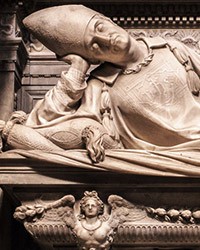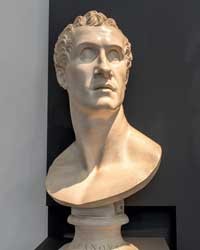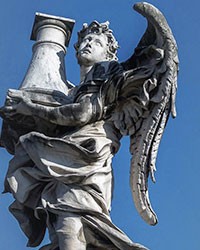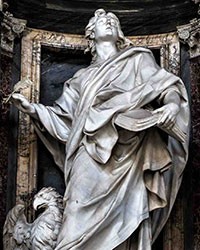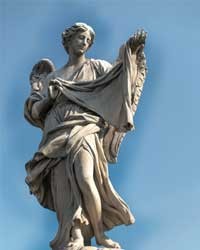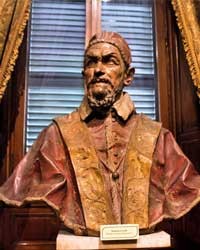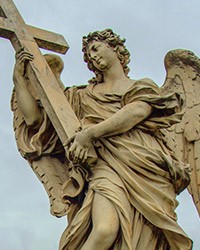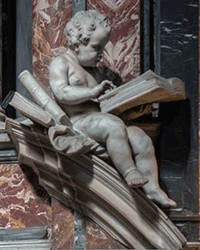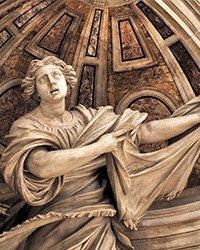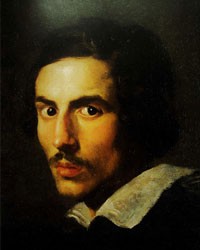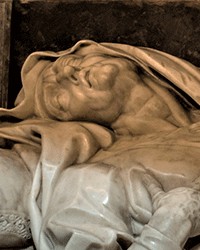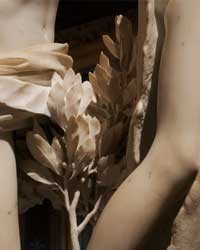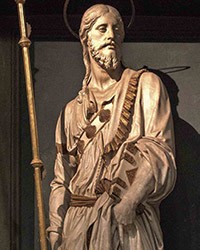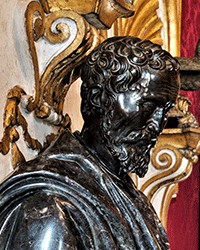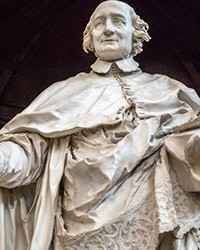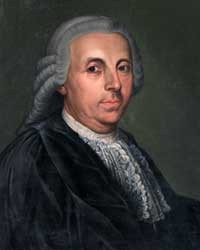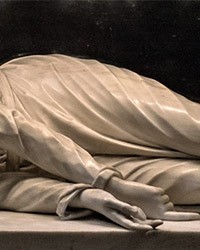
POSTACIE Sculptors
Sculptors
Andrea Sansovino (approx. 1467–1529) – the one who was able to bring the dead back to life
Antonio Canova (1757–1822) – praised by his contemporaries, disregarded by later generations
Bartolomeo Ammannati (1511–1592) – the beginnings of an outstanding career of a great Italian Mannerist
Giovanni (Gian) Lorenzo Bernini (1599–1680) – Impulsive, arrogant and ingenious favorite of the popes
Zgodnie z art. 13 ust. 1 i ust. 2 rozporządzenia Parlamentu Europejskiego i Rady (UE) 2016/679 z 27 kwietnia 2016 r. w sprawie ochrony osób fizycznych w związku z przetwarzaniem danych osobowych i w sprawie swobodnego przepływu takich danych oraz uchylenia dyrektywy 95/46/WE (RODO), informujemy, że Administratorem Pani/Pana danych osobowych jest firma: Econ-sk GmbH, Billbrookdeich 103, 22113 Hamburg, Niemcy
Przetwarzanie Pani/Pana danych osobowych będzie się odbywać na podstawie art. 6 RODO i w celu marketingowym Administrator powołuje się na prawnie uzasadniony interes, którym jest zbieranie danych statystycznych i analizowanie ruchu na stronie internetowej. Podanie danych osobowych na stronie internetowej http://roma-nonpertutti.com/ jest dobrowolne.
| Params | |
|---|---|
| 0 | |
| 1 | |
| 2 | |
| 3 | |
| 4 | |
| 5 | |
| 6 | |
| 7 | |
| 8 | |
| 9 | |
| Params | |
|---|---|
| 0 | |
| 1 | |
| 2 | |
| 3 | |
| 4 | |
| 5 | |
| 6 | |
| 7 | |
| 8 | |
| 9 | |
| 10 | |
| 11 | |
| 12 | |
| 13 | |
| 14 | |
| 15 | |
| 16 | |
| Params | |
|---|---|
| 0 | |
| 1 | |
| 2 | |
| 3 | |
| 4 | |
| 5 | |
| 6 | |
| 7 | |
| 8 | |
| 9 | |
| 10 | |
| 11 | |
| 12 | |
| 13 | |
| 14 | |
| 15 | |
| 16 | |
| Params | |
|---|---|
| 0 | |
| Params | |
|---|---|
| 0 | |
| 1 | |
| 2 | |
| 3 | |
| 4 | |
| 5 | |
| 6 | |
| 7 | |
| 8 | |
| 9 | |
| 10 | |
| 11 | |
| 12 | |
| 13 | |
| 14 | |
| 15 | |
| 16 | |
| Params | |
|---|---|
| 0 | |
| 1 | |
| 2 | |
| 3 | |
| 4 | |
| 5 | |
| 6 | |
| 7 | |
| 8 | |
| 9 | |
| 10 | |
| 11 | |
| 12 | |
| 13 | |
| 14 | |
| 15 | |
| 16 | |
| Params | |
|---|---|
| 0 | |
| 1 | |
| 2 | |
| 3 | |
| 4 | |
| 5 | |
| 6 | |
| 7 | |
| 8 | |
| 9 | |
| 10 | |
| 11 | |
| 12 | |
| 13 | |
| 14 | |
| 15 | |
| 16 | |
| Params | |
|---|---|
| 0 | |
| 1 | |
| 2 | |
| 3 | |
| 4 | |
| 5 | |
| 6 | |
| 7 | |
| 8 | |
| 9 | |
| 10 | |
| 11 | |
| 12 | |
| 13 | |
| 14 | |
| 15 | |
| 16 | |
| 17 | |
| 18 | |
| 19 | |
| 20 | |
| 21 | |
| 22 | |
select * from `articles_categories` where (`parent_id` is null and `status` = 'ACTIVE')4.36msbaza5943_roma| Metadata | |
|---|---|
| Bindings |
|
| Hints |
|
select * from `attributes` where (`table` = 'articles_categories')430μsbaza5943_roma| Metadata | |
|---|---|
| Bindings |
|
| Hints |
|
select * from `attributes_varchar` where `attribute_id` = '1' and `entity_id` = '1' and `lang` = 'en'430μsbaza5943_roma| Metadata | |
|---|---|
| Bindings |
|
| Hints |
|
select * from `articles_categories` where (`parent_id` = '1' and `status` = 'ACTIVE')370μsbaza5943_roma| Metadata | |
|---|---|
| Bindings |
|
| Hints |
|
select * from `attributes` where (`table` = 'articles_categories')400μsbaza5943_roma| Metadata | |
|---|---|
| Bindings |
|
| Hints |
|
select * from `attributes_varchar` where `attribute_id` = '1' and `entity_id` = '2' and `lang` = 'en'400μsbaza5943_roma| Metadata | |
|---|---|
| Bindings |
|
| Hints |
|
select * from `articles_categories` where (`parent_id` = '2' and `status` = 'ACTIVE')360μsbaza5943_roma| Metadata | |
|---|---|
| Bindings |
|
| Hints |
|
select * from `attributes` where (`table` = 'articles_categories')350μsbaza5943_roma| Metadata | |
|---|---|
| Bindings |
|
| Hints |
|
select * from `attributes_varchar` where `attribute_id` = '1' and `entity_id` = '3' and `lang` = 'en'410μsbaza5943_roma| Metadata | |
|---|---|
| Bindings |
|
| Hints |
|
select * from `articles_categories` where (`parent_id` = '3' and `status` = 'ACTIVE')440μsbaza5943_roma| Metadata | |
|---|---|
| Bindings |
|
| Hints |
|
select * from `attributes` where (`table` = 'articles_categories')340μsbaza5943_roma| Metadata | |
|---|---|
| Bindings |
|
| Hints |
|
select * from `attributes_varchar` where `attribute_id` = '1' and `entity_id` = '4' and `lang` = 'en'440μsbaza5943_roma| Metadata | |
|---|---|
| Bindings |
|
| Hints |
|
select * from `articles_categories` where (`parent_id` = '4' and `status` = 'ACTIVE')350μsbaza5943_roma| Metadata | |
|---|---|
| Bindings |
|
| Hints |
|
select * from `attributes` where (`table` = 'articles_categories')410μsbaza5943_roma| Metadata | |
|---|---|
| Bindings |
|
| Hints |
|
select * from `attributes_varchar` where `attribute_id` = '1' and `entity_id` = '5' and `lang` = 'en'330μsbaza5943_roma| Metadata | |
|---|---|
| Bindings |
|
| Hints |
|
select * from `articles_categories` where (`parent_id` = '5' and `status` = 'ACTIVE')420μsbaza5943_roma| Metadata | |
|---|---|
| Bindings |
|
| Hints |
|
select * from `attributes` where (`table` = 'articles_categories')350μsbaza5943_roma| Metadata | |
|---|---|
| Bindings |
|
| Hints |
|
select * from `attributes_varchar` where `attribute_id` = '1' and `entity_id` = '8' and `lang` = 'en'350μsbaza5943_roma| Metadata | |
|---|---|
| Bindings |
|
| Hints |
|
select * from `articles_categories` where (`parent_id` = '8' and `status` = 'ACTIVE')380μsbaza5943_roma| Metadata | |
|---|---|
| Bindings |
|
| Hints |
|
select * from `attributes` where (`table` = 'articles_categories')430μsbaza5943_roma| Metadata | |
|---|---|
| Bindings |
|
| Hints |
|
select * from `attributes_varchar` where `attribute_id` = '1' and `entity_id` = '9' and `lang` = 'en'440μsbaza5943_roma| Metadata | |
|---|---|
| Bindings |
|
| Hints |
|
select * from `articles_categories` where (`parent_id` = '9' and `status` = 'ACTIVE')570μsbaza5943_roma| Metadata | |
|---|---|
| Bindings |
|
| Hints |
|
select * from `attributes` where (`table` = 'articles_categories')390μsbaza5943_roma| Metadata | |
|---|---|
| Bindings |
|
| Hints |
|
select * from `attributes_varchar` where `attribute_id` = '1' and `entity_id` = '10' and `lang` = 'en'430μsbaza5943_roma| Metadata | |
|---|---|
| Bindings |
|
| Hints |
|
select * from `articles_categories` where (`parent_id` = '10' and `status` = 'ACTIVE')350μsbaza5943_roma| Metadata | |
|---|---|
| Bindings |
|
| Hints |
|
select * from `attributes` where (`table` = 'articles_categories')340μsbaza5943_roma| Metadata | |
|---|---|
| Bindings |
|
| Hints |
|
select * from `attributes_varchar` where `attribute_id` = '1' and `entity_id` = '11' and `lang` = 'en'410μsbaza5943_roma| Metadata | |
|---|---|
| Bindings |
|
| Hints |
|
select * from `articles_categories` where (`parent_id` = '11' and `status` = 'ACTIVE')350μsbaza5943_roma| Metadata | |
|---|---|
| Bindings |
|
| Hints |
|
select * from `attributes` where (`table` = 'articles_categories')400μsbaza5943_roma| Metadata | |
|---|---|
| Bindings |
|
| Hints |
|
select * from `attributes_varchar` where `attribute_id` = '1' and `entity_id` = '12' and `lang` = 'en'350μsbaza5943_roma| Metadata | |
|---|---|
| Bindings |
|
| Hints |
|
select * from `articles_categories` where (`parent_id` = '12' and `status` = 'ACTIVE')350μsbaza5943_roma| Metadata | |
|---|---|
| Bindings |
|
| Hints |
|
select * from `attributes` where (`table` = 'articles_categories')360μsbaza5943_roma| Metadata | |
|---|---|
| Bindings |
|
| Hints |
|
select * from `attributes_varchar` where `attribute_id` = '1' and `entity_id` = '13' and `lang` = 'en'390μsbaza5943_roma| Metadata | |
|---|---|
| Bindings |
|
| Hints |
|
select * from `articles_categories` where (`parent_id` = '13' and `status` = 'ACTIVE')500μsbaza5943_roma| Metadata | |
|---|---|
| Bindings |
|
| Hints |
|
select * from `attributes` where (`table` = 'articles_categories')330μsbaza5943_roma| Metadata | |
|---|---|
| Bindings |
|
| Hints |
|
select * from `attributes_varchar` where `attribute_id` = '1' and `entity_id` = '14' and `lang` = 'en'370μsbaza5943_roma| Metadata | |
|---|---|
| Bindings |
|
| Hints |
|
select * from `articles_categories` where (`parent_id` = '14' and `status` = 'ACTIVE')370μsbaza5943_roma| Metadata | |
|---|---|
| Bindings |
|
| Hints |
|
select * from `attributes` where (`table` = 'articles_categories')330μsbaza5943_roma| Metadata | |
|---|---|
| Bindings |
|
| Hints |
|
select * from `attributes_varchar` where `attribute_id` = '1' and `entity_id` = '15' and `lang` = 'en'310μsbaza5943_roma| Metadata | |
|---|---|
| Bindings |
|
| Hints |
|
select * from `articles_categories` where (`parent_id` = '15' and `status` = 'ACTIVE')390μsbaza5943_roma| Metadata | |
|---|---|
| Bindings |
|
| Hints |
|
select * from `attributes` where (`table` = 'articles_categories')350μsbaza5943_roma| Metadata | |
|---|---|
| Bindings |
|
| Hints |
|
select * from `attributes_varchar` where `attribute_id` = '1' and `entity_id` = '16' and `lang` = 'en'450μsbaza5943_roma| Metadata | |
|---|---|
| Bindings |
|
| Hints |
|
select * from `articles_categories` where (`parent_id` = '16' and `status` = 'ACTIVE')370μsbaza5943_roma| Metadata | |
|---|---|
| Bindings |
|
| Hints |
|
select * from `attributes` where (`table` = 'articles_categories')370μsbaza5943_roma| Metadata | |
|---|---|
| Bindings |
|
| Hints |
|
select * from `attributes_varchar` where `attribute_id` = '1' and `entity_id` = '17' and `lang` = 'en'360μsbaza5943_roma| Metadata | |
|---|---|
| Bindings |
|
| Hints |
|
select * from `articles_categories` where (`parent_id` = '17' and `status` = 'ACTIVE')360μsbaza5943_roma| Metadata | |
|---|---|
| Bindings |
|
| Hints |
|
select * from `attributes` where (`table` = 'articles_categories')380μsbaza5943_roma| Metadata | |
|---|---|
| Bindings |
|
| Hints |
|
select * from `attributes_varchar` where `attribute_id` = '1' and `entity_id` = '18' and `lang` = 'en'340μsbaza5943_roma| Metadata | |
|---|---|
| Bindings |
|
| Hints |
|
select * from `articles_categories` where (`parent_id` = '18' and `status` = 'ACTIVE')390μsbaza5943_roma| Metadata | |
|---|---|
| Bindings |
|
| Hints |
|
select * from `attributes` where (`table` = 'articles_categories')380μsbaza5943_roma| Metadata | |
|---|---|
| Bindings |
|
| Hints |
|
select * from `attributes_varchar` where `attribute_id` = '1' and `entity_id` = '19' and `lang` = 'en'530μsbaza5943_roma| Metadata | |
|---|---|
| Bindings |
|
| Hints |
|
select * from `articles_categories` where (`parent_id` = '19' and `status` = 'ACTIVE')340μsbaza5943_roma| Metadata | |
|---|---|
| Bindings |
|
| Hints |
|
select * from `attributes` where (`table` = 'articles_categories')640μsbaza5943_roma| Metadata | |
|---|---|
| Bindings |
|
| Hints |
|
select * from `attributes_varchar` where `attribute_id` = '1' and `entity_id` = '20' and `lang` = 'en'440μsbaza5943_roma| Metadata | |
|---|---|
| Bindings |
|
| Hints |
|
select * from `articles_categories` where (`parent_id` = '20' and `status` = 'ACTIVE')350μsbaza5943_roma| Metadata | |
|---|---|
| Bindings |
|
| Hints |
|
select * from `attributes` where (`table` = 'articles_categories')440μsbaza5943_roma| Metadata | |
|---|---|
| Bindings |
|
| Hints |
|
select * from `attributes_varchar` where `attribute_id` = '1' and `entity_id` = '21' and `lang` = 'en'350μsbaza5943_roma| Metadata | |
|---|---|
| Bindings |
|
| Hints |
|
select * from `articles_categories` where (`parent_id` = '21' and `status` = 'ACTIVE')380μsbaza5943_roma| Metadata | |
|---|---|
| Bindings |
|
| Hints |
|
select * from `attributes` where (`table` = 'articles_categories')380μsbaza5943_roma| Metadata | |
|---|---|
| Bindings |
|
| Hints |
|
select * from `attributes_varchar` where `attribute_id` = '1' and `entity_id` = '22' and `lang` = 'en'450μsbaza5943_roma| Metadata | |
|---|---|
| Bindings |
|
| Hints |
|
select * from `articles_categories` where (`parent_id` = '22' and `status` = 'ACTIVE')430μsbaza5943_roma| Metadata | |
|---|---|
| Bindings |
|
| Hints |
|
select * from `attributes` where (`table` = 'articles_categories')380μsbaza5943_roma| Metadata | |
|---|---|
| Bindings |
|
| Hints |
|
select * from `attributes_varchar` where `attribute_id` = '1' and `entity_id` = '23' and `lang` = 'en'550μsbaza5943_roma| Metadata | |
|---|---|
| Bindings |
|
| Hints |
|
select * from `articles_categories` where (`parent_id` = '23' and `status` = 'ACTIVE')480μsbaza5943_roma| Metadata | |
|---|---|
| Bindings |
|
| Hints |
|
select * from `attributes` where (`table` = 'articles_categories')420μsbaza5943_roma| Metadata | |
|---|---|
| Bindings |
|
| Hints |
|
select * from `attributes_varchar` where `attribute_id` = '1' and `entity_id` = '24' and `lang` = 'en'420μsbaza5943_roma| Metadata | |
|---|---|
| Bindings |
|
| Hints |
|
select * from `articles_categories` where (`parent_id` = '24' and `status` = 'ACTIVE')370μsbaza5943_roma| Metadata | |
|---|---|
| Bindings |
|
| Hints |
|
select * from `attributes` where (`table` = 'articles_categories')370μsbaza5943_roma| Metadata | |
|---|---|
| Bindings |
|
| Hints |
|
select * from `attributes_varchar` where `attribute_id` = '1' and `entity_id` = '25' and `lang` = 'en'520μsbaza5943_roma| Metadata | |
|---|---|
| Bindings |
|
| Hints |
|
select * from `articles_categories` where (`parent_id` = '25' and `status` = 'ACTIVE')430μsbaza5943_roma| Metadata | |
|---|---|
| Bindings |
|
| Hints |
|
select * from `attributes` where (`table` = 'articles_categories')430μsbaza5943_roma| Metadata | |
|---|---|
| Bindings |
|
| Hints |
|
select * from `attributes_varchar` where `attribute_id` = '1' and `entity_id` = '26' and `lang` = 'en'370μsbaza5943_roma| Metadata | |
|---|---|
| Bindings |
|
| Hints |
|
select * from `articles_categories` where (`parent_id` = '26' and `status` = 'ACTIVE')360μsbaza5943_roma| Metadata | |
|---|---|
| Bindings |
|
| Hints |
|
select * from `attributes` where (`table` = 'articles_categories')330μsbaza5943_roma| Metadata | |
|---|---|
| Bindings |
|
| Hints |
|
select * from `attributes_varchar` where `attribute_id` = '1' and `entity_id` = '27' and `lang` = 'en'510μsbaza5943_roma| Metadata | |
|---|---|
| Bindings |
|
| Hints |
|
select * from `articles_categories` where (`parent_id` = '27' and `status` = 'ACTIVE')480μsbaza5943_roma| Metadata | |
|---|---|
| Bindings |
|
| Hints |
|
select * from `attributes` where (`table` = 'articles_categories')350μsbaza5943_roma| Metadata | |
|---|---|
| Bindings |
|
| Hints |
|
select * from `attributes_varchar` where `attribute_id` = '1' and `entity_id` = '28' and `lang` = 'en'310μsbaza5943_roma| Metadata | |
|---|---|
| Bindings |
|
| Hints |
|
select * from `articles_categories` where (`parent_id` = '28' and `status` = 'ACTIVE')420μsbaza5943_roma| Metadata | |
|---|---|
| Bindings |
|
| Hints |
|
select * from `attributes` where (`table` = 'articles_categories')340μsbaza5943_roma| Metadata | |
|---|---|
| Bindings |
|
| Hints |
|
select * from `attributes_varchar` where `attribute_id` = '1' and `entity_id` = '29' and `lang` = 'en'350μsbaza5943_roma| Metadata | |
|---|---|
| Bindings |
|
| Hints |
|
select * from `articles_categories` where (`parent_id` = '29' and `status` = 'ACTIVE')480μsbaza5943_roma| Metadata | |
|---|---|
| Bindings |
|
| Hints |
|
select * from `settings`370μsbaza5943_roma| Metadata | |
|---|---|
| Hints |
|
select * from `articles_categories` where `articles_categories`.`id` = '4' limit 1610μsbaza5943_roma| Metadata | |
|---|---|
| Bindings |
|
| Hints |
|
select * from `articles` where exists (select * from `articles_categories` inner join `articles_categories_join` on `articles_categories`.`id` = `articles_categories_join`.`category_id` where `articles`.`id` = `articles_categories_join`.`article_id` and `status` = 'ACTIVE') and `articles`.`deleted_at` is null order by `created_at` desc limit 3450μsbaza5943_roma| Metadata | |
|---|---|
| Bindings |
|
| Hints |
|
select * from `attributes` where (`table` = 'articles')360μsbaza5943_roma| Metadata | |
|---|---|
| Bindings |
|
| Hints |
|
select * from `attributes_varchar` where `attribute_id` = '2' and `entity_id` = '556' and `lang` = 'en'350μsbaza5943_roma| Metadata | |
|---|---|
| Bindings |
|
| Hints |
|
select * from `attributes_text` where `attribute_id` = '3' and `entity_id` = '556' and `lang` = 'en'340μsbaza5943_roma| Metadata | |
|---|---|
| Bindings |
|
| Hints |
|
select * from `attributes_text` where `attribute_id` = '6' and `entity_id` = '556' and `lang` = 'en'360μsbaza5943_roma| Metadata | |
|---|---|
| Bindings |
|
| Hints |
|
select * from `urls` where `table` = 'articles' and `entity_id` = '556'330μsbaza5943_roma| Metadata | |
|---|---|
| Bindings |
|
| Hints |
|
select * from `articles_photos` where `article_id` = '556'440μsbaza5943_roma| Metadata | |
|---|---|
| Bindings |
|
| Hints |
|
select * from `attributes` where (`table` = 'articles_photos')340μsbaza5943_roma| Metadata | |
|---|---|
| Bindings |
|
| Hints |
|
select * from `attributes_varchar` where `attribute_id` = '5' and `entity_id` = '7979' and `lang` = 'en'400μsbaza5943_roma| Metadata | |
|---|---|
| Bindings |
|
| Hints |
|
select * from `attributes` where (`table` = 'articles_photos')450μsbaza5943_roma| Metadata | |
|---|---|
| Bindings |
|
| Hints |
|
select * from `attributes_varchar` where `attribute_id` = '5' and `entity_id` = '7980' and `lang` = 'en'320μsbaza5943_roma| Metadata | |
|---|---|
| Bindings |
|
| Hints |
|
select * from `attributes` where (`table` = 'articles_photos')340μsbaza5943_roma| Metadata | |
|---|---|
| Bindings |
|
| Hints |
|
select * from `attributes_varchar` where `attribute_id` = '5' and `entity_id` = '7982' and `lang` = 'en'300μsbaza5943_roma| Metadata | |
|---|---|
| Bindings |
|
| Hints |
|
select * from `articles_photos` where `article_id` = '556' and `main_photo` = '1'420μsbaza5943_roma| Metadata | |
|---|---|
| Bindings |
|
| Hints |
|
select * from `attributes` where (`table` = 'articles_photos')350μsbaza5943_roma| Metadata | |
|---|---|
| Bindings |
|
| Hints |
|
select * from `attributes_varchar` where `attribute_id` = '5' and `entity_id` = '7979' and `lang` = 'en'360μsbaza5943_roma| Metadata | |
|---|---|
| Bindings |
|
| Hints |
|
select * from `attributes` where (`table` = 'articles')330μsbaza5943_roma| Metadata | |
|---|---|
| Bindings |
|
| Hints |
|
select * from `attributes_varchar` where `attribute_id` = '2' and `entity_id` = '555' and `lang` = 'en'400μsbaza5943_roma| Metadata | |
|---|---|
| Bindings |
|
| Hints |
|
select * from `attributes_text` where `attribute_id` = '3' and `entity_id` = '555' and `lang` = 'en'390μsbaza5943_roma| Metadata | |
|---|---|
| Bindings |
|
| Hints |
|
select * from `attributes_text` where `attribute_id` = '6' and `entity_id` = '555' and `lang` = 'en'350μsbaza5943_roma| Metadata | |
|---|---|
| Bindings |
|
| Hints |
|
select * from `urls` where `table` = 'articles' and `entity_id` = '555'420μsbaza5943_roma| Metadata | |
|---|---|
| Bindings |
|
| Hints |
|
select * from `articles_photos` where `article_id` = '555'470μsbaza5943_roma| Metadata | |
|---|---|
| Bindings |
|
| Hints |
|
select * from `attributes` where (`table` = 'articles_photos')370μsbaza5943_roma| Metadata | |
|---|---|
| Bindings |
|
| Hints |
|
select * from `attributes_varchar` where `attribute_id` = '5' and `entity_id` = '7956' and `lang` = 'en'470μsbaza5943_roma| Metadata | |
|---|---|
| Bindings |
|
| Hints |
|
select * from `attributes` where (`table` = 'articles_photos')340μsbaza5943_roma| Metadata | |
|---|---|
| Bindings |
|
| Hints |
|
select * from `attributes_varchar` where `attribute_id` = '5' and `entity_id` = '7957' and `lang` = 'en'350μsbaza5943_roma| Metadata | |
|---|---|
| Bindings |
|
| Hints |
|
select * from `attributes` where (`table` = 'articles_photos')370μsbaza5943_roma| Metadata | |
|---|---|
| Bindings |
|
| Hints |
|
select * from `attributes_varchar` where `attribute_id` = '5' and `entity_id` = '7958' and `lang` = 'en'360μsbaza5943_roma| Metadata | |
|---|---|
| Bindings |
|
| Hints |
|
select * from `attributes` where (`table` = 'articles_photos')340μsbaza5943_roma| Metadata | |
|---|---|
| Bindings |
|
| Hints |
|
select * from `attributes_varchar` where `attribute_id` = '5' and `entity_id` = '7959' and `lang` = 'en'360μsbaza5943_roma| Metadata | |
|---|---|
| Bindings |
|
| Hints |
|
select * from `attributes` where (`table` = 'articles_photos')340μsbaza5943_roma| Metadata | |
|---|---|
| Bindings |
|
| Hints |
|
select * from `attributes_varchar` where `attribute_id` = '5' and `entity_id` = '7960' and `lang` = 'en'500μsbaza5943_roma| Metadata | |
|---|---|
| Bindings |
|
| Hints |
|
select * from `attributes` where (`table` = 'articles_photos')340μsbaza5943_roma| Metadata | |
|---|---|
| Bindings |
|
| Hints |
|
select * from `attributes_varchar` where `attribute_id` = '5' and `entity_id` = '7962' and `lang` = 'en'400μsbaza5943_roma| Metadata | |
|---|---|
| Bindings |
|
| Hints |
|
select * from `attributes` where (`table` = 'articles_photos')550μsbaza5943_roma| Metadata | |
|---|---|
| Bindings |
|
| Hints |
|
select * from `attributes_varchar` where `attribute_id` = '5' and `entity_id` = '7963' and `lang` = 'en'460μsbaza5943_roma| Metadata | |
|---|---|
| Bindings |
|
| Hints |
|
select * from `attributes` where (`table` = 'articles_photos')420μsbaza5943_roma| Metadata | |
|---|---|
| Bindings |
|
| Hints |
|
select * from `attributes_varchar` where `attribute_id` = '5' and `entity_id` = '7964' and `lang` = 'en'450μsbaza5943_roma| Metadata | |
|---|---|
| Bindings |
|
| Hints |
|
select * from `attributes` where (`table` = 'articles_photos')400μsbaza5943_roma| Metadata | |
|---|---|
| Bindings |
|
| Hints |
|
select * from `attributes_varchar` where `attribute_id` = '5' and `entity_id` = '7965' and `lang` = 'en'330μsbaza5943_roma| Metadata | |
|---|---|
| Bindings |
|
| Hints |
|
select * from `attributes` where (`table` = 'articles_photos')420μsbaza5943_roma| Metadata | |
|---|---|
| Bindings |
|
| Hints |
|
select * from `attributes_varchar` where `attribute_id` = '5' and `entity_id` = '7966' and `lang` = 'en'450μsbaza5943_roma| Metadata | |
|---|---|
| Bindings |
|
| Hints |
|
select * from `attributes` where (`table` = 'articles_photos')420μsbaza5943_roma| Metadata | |
|---|---|
| Bindings |
|
| Hints |
|
select * from `attributes_varchar` where `attribute_id` = '5' and `entity_id` = '7967' and `lang` = 'en'410μsbaza5943_roma| Metadata | |
|---|---|
| Bindings |
|
| Hints |
|
select * from `attributes` where (`table` = 'articles_photos')370μsbaza5943_roma| Metadata | |
|---|---|
| Bindings |
|
| Hints |
|
select * from `attributes_varchar` where `attribute_id` = '5' and `entity_id` = '7968' and `lang` = 'en'410μsbaza5943_roma| Metadata | |
|---|---|
| Bindings |
|
| Hints |
|
select * from `attributes` where (`table` = 'articles_photos')340μsbaza5943_roma| Metadata | |
|---|---|
| Bindings |
|
| Hints |
|
select * from `attributes_varchar` where `attribute_id` = '5' and `entity_id` = '7969' and `lang` = 'en'370μsbaza5943_roma| Metadata | |
|---|---|
| Bindings |
|
| Hints |
|
select * from `attributes` where (`table` = 'articles_photos')320μsbaza5943_roma| Metadata | |
|---|---|
| Bindings |
|
| Hints |
|
select * from `attributes_varchar` where `attribute_id` = '5' and `entity_id` = '7970' and `lang` = 'en'300μsbaza5943_roma| Metadata | |
|---|---|
| Bindings |
|
| Hints |
|
select * from `attributes` where (`table` = 'articles_photos')340μsbaza5943_roma| Metadata | |
|---|---|
| Bindings |
|
| Hints |
|
select * from `attributes_varchar` where `attribute_id` = '5' and `entity_id` = '7971' and `lang` = 'en'450μsbaza5943_roma| Metadata | |
|---|---|
| Bindings |
|
| Hints |
|
select * from `attributes` where (`table` = 'articles_photos')370μsbaza5943_roma| Metadata | |
|---|---|
| Bindings |
|
| Hints |
|
select * from `attributes_varchar` where `attribute_id` = '5' and `entity_id` = '7972' and `lang` = 'en'350μsbaza5943_roma| Metadata | |
|---|---|
| Bindings |
|
| Hints |
|
select * from `attributes` where (`table` = 'articles_photos')470μsbaza5943_roma| Metadata | |
|---|---|
| Bindings |
|
| Hints |
|
select * from `attributes_varchar` where `attribute_id` = '5' and `entity_id` = '7973' and `lang` = 'en'440μsbaza5943_roma| Metadata | |
|---|---|
| Bindings |
|
| Hints |
|
select * from `attributes` where (`table` = 'articles_photos')390μsbaza5943_roma| Metadata | |
|---|---|
| Bindings |
|
| Hints |
|
select * from `attributes_varchar` where `attribute_id` = '5' and `entity_id` = '7974' and `lang` = 'en'400μsbaza5943_roma| Metadata | |
|---|---|
| Bindings |
|
| Hints |
|
select * from `attributes` where (`table` = 'articles_photos')410μsbaza5943_roma| Metadata | |
|---|---|
| Bindings |
|
| Hints |
|
select * from `attributes_varchar` where `attribute_id` = '5' and `entity_id` = '7975' and `lang` = 'en'630μsbaza5943_roma| Metadata | |
|---|---|
| Bindings |
|
| Hints |
|
select * from `attributes` where (`table` = 'articles_photos')370μsbaza5943_roma| Metadata | |
|---|---|
| Bindings |
|
| Hints |
|
select * from `attributes_varchar` where `attribute_id` = '5' and `entity_id` = '7976' and `lang` = 'en'360μsbaza5943_roma| Metadata | |
|---|---|
| Bindings |
|
| Hints |
|
select * from `articles_photos` where `article_id` = '555' and `main_photo` = '1'380μsbaza5943_roma| Metadata | |
|---|---|
| Bindings |
|
| Hints |
|
select * from `attributes` where (`table` = 'articles_photos')520μsbaza5943_roma| Metadata | |
|---|---|
| Bindings |
|
| Hints |
|
select * from `attributes_varchar` where `attribute_id` = '5' and `entity_id` = '7974' and `lang` = 'en'400μsbaza5943_roma| Metadata | |
|---|---|
| Bindings |
|
| Hints |
|
select * from `attributes` where (`table` = 'articles')370μsbaza5943_roma| Metadata | |
|---|---|
| Bindings |
|
| Hints |
|
select * from `attributes_varchar` where `attribute_id` = '2' and `entity_id` = '554' and `lang` = 'en'430μsbaza5943_roma| Metadata | |
|---|---|
| Bindings |
|
| Hints |
|
select * from `attributes_text` where `attribute_id` = '3' and `entity_id` = '554' and `lang` = 'en'420μsbaza5943_roma| Metadata | |
|---|---|
| Bindings |
|
| Hints |
|
select * from `attributes_text` where `attribute_id` = '6' and `entity_id` = '554' and `lang` = 'en'410μsbaza5943_roma| Metadata | |
|---|---|
| Bindings |
|
| Hints |
|
select * from `urls` where `table` = 'articles' and `entity_id` = '554'380μsbaza5943_roma| Metadata | |
|---|---|
| Bindings |
|
| Hints |
|
select * from `articles_photos` where `article_id` = '554'510μsbaza5943_roma| Metadata | |
|---|---|
| Bindings |
|
| Hints |
|
select * from `attributes` where (`table` = 'articles_photos')390μsbaza5943_roma| Metadata | |
|---|---|
| Bindings |
|
| Hints |
|
select * from `attributes_varchar` where `attribute_id` = '5' and `entity_id` = '7946' and `lang` = 'en'530μsbaza5943_roma| Metadata | |
|---|---|
| Bindings |
|
| Hints |
|
select * from `attributes` where (`table` = 'articles_photos')410μsbaza5943_roma| Metadata | |
|---|---|
| Bindings |
|
| Hints |
|
select * from `attributes_varchar` where `attribute_id` = '5' and `entity_id` = '7947' and `lang` = 'en'420μsbaza5943_roma| Metadata | |
|---|---|
| Bindings |
|
| Hints |
|
select * from `attributes` where (`table` = 'articles_photos')380μsbaza5943_roma| Metadata | |
|---|---|
| Bindings |
|
| Hints |
|
select * from `attributes_varchar` where `attribute_id` = '5' and `entity_id` = '7948' and `lang` = 'en'390μsbaza5943_roma| Metadata | |
|---|---|
| Bindings |
|
| Hints |
|
select * from `attributes` where (`table` = 'articles_photos')460μsbaza5943_roma| Metadata | |
|---|---|
| Bindings |
|
| Hints |
|
select * from `attributes_varchar` where `attribute_id` = '5' and `entity_id` = '7949' and `lang` = 'en'700μsbaza5943_roma| Metadata | |
|---|---|
| Bindings |
|
| Hints |
|
select * from `attributes` where (`table` = 'articles_photos')390μsbaza5943_roma| Metadata | |
|---|---|
| Bindings |
|
| Hints |
|
select * from `attributes_varchar` where `attribute_id` = '5' and `entity_id` = '7950' and `lang` = 'en'420μsbaza5943_roma| Metadata | |
|---|---|
| Bindings |
|
| Hints |
|
select * from `attributes` where (`table` = 'articles_photos')350μsbaza5943_roma| Metadata | |
|---|---|
| Bindings |
|
| Hints |
|
select * from `attributes_varchar` where `attribute_id` = '5' and `entity_id` = '7951' and `lang` = 'en'410μsbaza5943_roma| Metadata | |
|---|---|
| Bindings |
|
| Hints |
|
select * from `attributes` where (`table` = 'articles_photos')360μsbaza5943_roma| Metadata | |
|---|---|
| Bindings |
|
| Hints |
|
select * from `attributes_varchar` where `attribute_id` = '5' and `entity_id` = '7952' and `lang` = 'en'400μsbaza5943_roma| Metadata | |
|---|---|
| Bindings |
|
| Hints |
|
select * from `attributes` where (`table` = 'articles_photos')480μsbaza5943_roma| Metadata | |
|---|---|
| Bindings |
|
| Hints |
|
select * from `attributes_varchar` where `attribute_id` = '5' and `entity_id` = '7953' and `lang` = 'en'420μsbaza5943_roma| Metadata | |
|---|---|
| Bindings |
|
| Hints |
|
select * from `attributes` where (`table` = 'articles_photos')760μsbaza5943_roma| Metadata | |
|---|---|
| Bindings |
|
| Hints |
|
select * from `attributes_varchar` where `attribute_id` = '5' and `entity_id` = '7954' and `lang` = 'en'590μsbaza5943_roma| Metadata | |
|---|---|
| Bindings |
|
| Hints |
|
select * from `attributes` where (`table` = 'articles_photos')360μsbaza5943_roma| Metadata | |
|---|---|
| Bindings |
|
| Hints |
|
select * from `attributes_varchar` where `attribute_id` = '5' and `entity_id` = '7955' and `lang` = 'en'420μsbaza5943_roma| Metadata | |
|---|---|
| Bindings |
|
| Hints |
|
select * from `articles_photos` where `article_id` = '554' and `main_photo` = '1'410μsbaza5943_roma| Metadata | |
|---|---|
| Bindings |
|
| Hints |
|
select * from `attributes` where (`table` = 'articles_photos')350μsbaza5943_roma| Metadata | |
|---|---|
| Bindings |
|
| Hints |
|
select * from `attributes_varchar` where `attribute_id` = '5' and `entity_id` = '7952' and `lang` = 'en'340μsbaza5943_roma| Metadata | |
|---|---|
| Bindings |
|
| Hints |
|
select * from `attributes` where `key` in ('name') and (`table` = 'articles_categories')390μsbaza5943_roma| Metadata | |
|---|---|
| Bindings |
|
| Hints |
|
select * from `attributes_varchar` where `attribute_id` = '1' and `entity_id` = '4' and `lang` = 'en'350μsbaza5943_roma| Metadata | |
|---|---|
| Bindings |
|
| Hints |
|
select * from `articles_categories` where `parent_id` = '4'340μsbaza5943_roma| Metadata | |
|---|---|
| Bindings |
|
| Hints |
|
select * from `articles_tags` where `status` = 'ACTIVE' and `category_id` = '4'350μsbaza5943_roma| Metadata | |
|---|---|
| Bindings |
|
| Hints |
|
select * from `articles_categories` where (`parent_id` = '4')320μsbaza5943_roma| Metadata | |
|---|---|
| Bindings |
|
| Hints |
|
select * from `articles` where exists (select * from `articles_categories` inner join `articles_categories_join` on `articles_categories`.`id` = `articles_categories_join`.`category_id` where `articles`.`id` = `articles_categories_join`.`article_id` and `category_id` in ('4') and `status` = 'ACTIVE') and `articles`.`deleted_at` is null order by `name` asc500μsbaza5943_roma| Metadata | |
|---|---|
| Bindings |
|
| Hints |
|
select * from `attributes` where (`table` = 'articles')390μsbaza5943_roma| Metadata | |
|---|---|
| Bindings |
|
| Hints |
|
select * from `attributes_varchar` where `attribute_id` = '2' and `entity_id` = '10' and `lang` = 'en'350μsbaza5943_roma| Metadata | |
|---|---|
| Bindings |
|
| Hints |
|
select * from `attributes_text` where `attribute_id` = '3' and `entity_id` = '10' and `lang` = 'en'620μsbaza5943_roma| Metadata | |
|---|---|
| Bindings |
|
| Hints |
|
select * from `attributes_text` where `attribute_id` = '6' and `entity_id` = '10' and `lang` = 'en'350μsbaza5943_roma| Metadata | |
|---|---|
| Bindings |
|
| Hints |
|
select * from `urls` where `table` = 'articles' and `entity_id` = '10'390μsbaza5943_roma| Metadata | |
|---|---|
| Bindings |
|
| Hints |
|
select * from `attributes` where (`table` = 'articles')370μsbaza5943_roma| Metadata | |
|---|---|
| Bindings |
|
| Hints |
|
select * from `attributes_varchar` where `attribute_id` = '2' and `entity_id` = '306' and `lang` = 'en'490μsbaza5943_roma| Metadata | |
|---|---|
| Bindings |
|
| Hints |
|
select * from `attributes_text` where `attribute_id` = '3' and `entity_id` = '306' and `lang` = 'en'590μsbaza5943_roma| Metadata | |
|---|---|
| Bindings |
|
| Hints |
|
select * from `attributes_text` where `attribute_id` = '6' and `entity_id` = '306' and `lang` = 'en'450μsbaza5943_roma| Metadata | |
|---|---|
| Bindings |
|
| Hints |
|
select * from `urls` where `table` = 'articles' and `entity_id` = '306'440μsbaza5943_roma| Metadata | |
|---|---|
| Bindings |
|
| Hints |
|
select * from `attributes` where (`table` = 'articles')370μsbaza5943_roma| Metadata | |
|---|---|
| Bindings |
|
| Hints |
|
select * from `attributes_varchar` where `attribute_id` = '2' and `entity_id` = '28' and `lang` = 'en'360μsbaza5943_roma| Metadata | |
|---|---|
| Bindings |
|
| Hints |
|
select * from `attributes_text` where `attribute_id` = '3' and `entity_id` = '28' and `lang` = 'en'500μsbaza5943_roma| Metadata | |
|---|---|
| Bindings |
|
| Hints |
|
select * from `attributes_text` where `attribute_id` = '6' and `entity_id` = '28' and `lang` = 'en'520μsbaza5943_roma| Metadata | |
|---|---|
| Bindings |
|
| Hints |
|
select * from `urls` where `table` = 'articles' and `entity_id` = '28'360μsbaza5943_roma| Metadata | |
|---|---|
| Bindings |
|
| Hints |
|
select * from `attributes` where (`table` = 'articles')680μsbaza5943_roma| Metadata | |
|---|---|
| Bindings |
|
| Hints |
|
select * from `attributes_varchar` where `attribute_id` = '2' and `entity_id` = '265' and `lang` = 'en'470μsbaza5943_roma| Metadata | |
|---|---|
| Bindings |
|
| Hints |
|
select * from `attributes_text` where `attribute_id` = '3' and `entity_id` = '265' and `lang` = 'en'470μsbaza5943_roma| Metadata | |
|---|---|
| Bindings |
|
| Hints |
|
select * from `attributes_text` where `attribute_id` = '6' and `entity_id` = '265' and `lang` = 'en'450μsbaza5943_roma| Metadata | |
|---|---|
| Bindings |
|
| Hints |
|
select * from `urls` where `table` = 'articles' and `entity_id` = '265'400μsbaza5943_roma| Metadata | |
|---|---|
| Bindings |
|
| Hints |
|
select * from `attributes` where (`table` = 'articles')370μsbaza5943_roma| Metadata | |
|---|---|
| Bindings |
|
| Hints |
|
select * from `attributes_varchar` where `attribute_id` = '2' and `entity_id` = '420' and `lang` = 'en'370μsbaza5943_roma| Metadata | |
|---|---|
| Bindings |
|
| Hints |
|
select * from `attributes_text` where `attribute_id` = '3' and `entity_id` = '420' and `lang` = 'en'610μsbaza5943_roma| Metadata | |
|---|---|
| Bindings |
|
| Hints |
|
select * from `attributes_text` where `attribute_id` = '6' and `entity_id` = '420' and `lang` = 'en'470μsbaza5943_roma| Metadata | |
|---|---|
| Bindings |
|
| Hints |
|
select * from `urls` where `table` = 'articles' and `entity_id` = '420'420μsbaza5943_roma| Metadata | |
|---|---|
| Bindings |
|
| Hints |
|
select * from `attributes` where (`table` = 'articles')450μsbaza5943_roma| Metadata | |
|---|---|
| Bindings |
|
| Hints |
|
select * from `attributes_varchar` where `attribute_id` = '2' and `entity_id` = '270' and `lang` = 'en'350μsbaza5943_roma| Metadata | |
|---|---|
| Bindings |
|
| Hints |
|
select * from `attributes_text` where `attribute_id` = '3' and `entity_id` = '270' and `lang` = 'en'450μsbaza5943_roma| Metadata | |
|---|---|
| Bindings |
|
| Hints |
|
select * from `attributes_text` where `attribute_id` = '6' and `entity_id` = '270' and `lang` = 'en'480μsbaza5943_roma| Metadata | |
|---|---|
| Bindings |
|
| Hints |
|
select * from `urls` where `table` = 'articles' and `entity_id` = '270'360μsbaza5943_roma| Metadata | |
|---|---|
| Bindings |
|
| Hints |
|
select * from `attributes` where (`table` = 'articles')500μsbaza5943_roma| Metadata | |
|---|---|
| Bindings |
|
| Hints |
|
select * from `attributes_varchar` where `attribute_id` = '2' and `entity_id` = '50' and `lang` = 'en'320μsbaza5943_roma| Metadata | |
|---|---|
| Bindings |
|
| Hints |
|
select * from `attributes_text` where `attribute_id` = '3' and `entity_id` = '50' and `lang` = 'en'600μsbaza5943_roma| Metadata | |
|---|---|
| Bindings |
|
| Hints |
|
select * from `attributes_text` where `attribute_id` = '6' and `entity_id` = '50' and `lang` = 'en'268.37msbaza5943_roma| Metadata | |
|---|---|
| Bindings |
|
| Hints |
|
select * from `urls` where `table` = 'articles' and `entity_id` = '50'610μsbaza5943_roma| Metadata | |
|---|---|
| Bindings |
|
| Hints |
|
select * from `attributes` where (`table` = 'articles')420μsbaza5943_roma| Metadata | |
|---|---|
| Bindings |
|
| Hints |
|
select * from `attributes_varchar` where `attribute_id` = '2' and `entity_id` = '79' and `lang` = 'en'590μsbaza5943_roma| Metadata | |
|---|---|
| Bindings |
|
| Hints |
|
select * from `attributes_text` where `attribute_id` = '3' and `entity_id` = '79' and `lang` = 'en'840μsbaza5943_roma| Metadata | |
|---|---|
| Bindings |
|
| Hints |
|
select * from `attributes_text` where `attribute_id` = '6' and `entity_id` = '79' and `lang` = 'en'540μsbaza5943_roma| Metadata | |
|---|---|
| Bindings |
|
| Hints |
|
select * from `urls` where `table` = 'articles' and `entity_id` = '79'550μsbaza5943_roma| Metadata | |
|---|---|
| Bindings |
|
| Hints |
|
select * from `attributes` where (`table` = 'articles')490μsbaza5943_roma| Metadata | |
|---|---|
| Bindings |
|
| Hints |
|
select * from `attributes_varchar` where `attribute_id` = '2' and `entity_id` = '52' and `lang` = 'en'440μsbaza5943_roma| Metadata | |
|---|---|
| Bindings |
|
| Hints |
|
select * from `attributes_text` where `attribute_id` = '3' and `entity_id` = '52' and `lang` = 'en'610μsbaza5943_roma| Metadata | |
|---|---|
| Bindings |
|
| Hints |
|
select * from `attributes_text` where `attribute_id` = '6' and `entity_id` = '52' and `lang` = 'en'630μsbaza5943_roma| Metadata | |
|---|---|
| Bindings |
|
| Hints |
|
select * from `urls` where `table` = 'articles' and `entity_id` = '52'500μsbaza5943_roma| Metadata | |
|---|---|
| Bindings |
|
| Hints |
|
select * from `attributes` where (`table` = 'articles')390μsbaza5943_roma| Metadata | |
|---|---|
| Bindings |
|
| Hints |
|
select * from `attributes_varchar` where `attribute_id` = '2' and `entity_id` = '33' and `lang` = 'en'480μsbaza5943_roma| Metadata | |
|---|---|
| Bindings |
|
| Hints |
|
select * from `attributes_text` where `attribute_id` = '3' and `entity_id` = '33' and `lang` = 'en'410μsbaza5943_roma| Metadata | |
|---|---|
| Bindings |
|
| Hints |
|
select * from `attributes_text` where `attribute_id` = '6' and `entity_id` = '33' and `lang` = 'en'470μsbaza5943_roma| Metadata | |
|---|---|
| Bindings |
|
| Hints |
|
select * from `urls` where `table` = 'articles' and `entity_id` = '33'550μsbaza5943_roma| Metadata | |
|---|---|
| Bindings |
|
| Hints |
|
select * from `attributes` where (`table` = 'articles')380μsbaza5943_roma| Metadata | |
|---|---|
| Bindings |
|
| Hints |
|
select * from `attributes_varchar` where `attribute_id` = '2' and `entity_id` = '206' and `lang` = 'en'490μsbaza5943_roma| Metadata | |
|---|---|
| Bindings |
|
| Hints |
|
select * from `attributes_text` where `attribute_id` = '3' and `entity_id` = '206' and `lang` = 'en'560μsbaza5943_roma| Metadata | |
|---|---|
| Bindings |
|
| Hints |
|
select * from `attributes_text` where `attribute_id` = '6' and `entity_id` = '206' and `lang` = 'en'560μsbaza5943_roma| Metadata | |
|---|---|
| Bindings |
|
| Hints |
|
select * from `urls` where `table` = 'articles' and `entity_id` = '206'570μsbaza5943_roma| Metadata | |
|---|---|
| Bindings |
|
| Hints |
|
select * from `attributes` where (`table` = 'articles')620μsbaza5943_roma| Metadata | |
|---|---|
| Bindings |
|
| Hints |
|
select * from `attributes_varchar` where `attribute_id` = '2' and `entity_id` = '263' and `lang` = 'en'460μsbaza5943_roma| Metadata | |
|---|---|
| Bindings |
|
| Hints |
|
select * from `attributes_text` where `attribute_id` = '3' and `entity_id` = '263' and `lang` = 'en'760μsbaza5943_roma| Metadata | |
|---|---|
| Bindings |
|
| Hints |
|
select * from `attributes_text` where `attribute_id` = '6' and `entity_id` = '263' and `lang` = 'en'480μsbaza5943_roma| Metadata | |
|---|---|
| Bindings |
|
| Hints |
|
select * from `urls` where `table` = 'articles' and `entity_id` = '263'450μsbaza5943_roma| Metadata | |
|---|---|
| Bindings |
|
| Hints |
|
select * from `attributes` where (`table` = 'articles')460μsbaza5943_roma| Metadata | |
|---|---|
| Bindings |
|
| Hints |
|
select * from `attributes_varchar` where `attribute_id` = '2' and `entity_id` = '166' and `lang` = 'en'370μsbaza5943_roma| Metadata | |
|---|---|
| Bindings |
|
| Hints |
|
select * from `attributes_text` where `attribute_id` = '3' and `entity_id` = '166' and `lang` = 'en'490μsbaza5943_roma| Metadata | |
|---|---|
| Bindings |
|
| Hints |
|
select * from `attributes_text` where `attribute_id` = '6' and `entity_id` = '166' and `lang` = 'en'440μsbaza5943_roma| Metadata | |
|---|---|
| Bindings |
|
| Hints |
|
select * from `urls` where `table` = 'articles' and `entity_id` = '166'360μsbaza5943_roma| Metadata | |
|---|---|
| Bindings |
|
| Hints |
|
select * from `attributes` where (`table` = 'articles')360μsbaza5943_roma| Metadata | |
|---|---|
| Bindings |
|
| Hints |
|
select * from `attributes_varchar` where `attribute_id` = '2' and `entity_id` = '53' and `lang` = 'en'410μsbaza5943_roma| Metadata | |
|---|---|
| Bindings |
|
| Hints |
|
select * from `attributes_text` where `attribute_id` = '3' and `entity_id` = '53' and `lang` = 'en'500μsbaza5943_roma| Metadata | |
|---|---|
| Bindings |
|
| Hints |
|
select * from `attributes_text` where `attribute_id` = '6' and `entity_id` = '53' and `lang` = 'en'530μsbaza5943_roma| Metadata | |
|---|---|
| Bindings |
|
| Hints |
|
select * from `urls` where `table` = 'articles' and `entity_id` = '53'390μsbaza5943_roma| Metadata | |
|---|---|
| Bindings |
|
| Hints |
|
select * from `attributes` where (`table` = 'articles')360μsbaza5943_roma| Metadata | |
|---|---|
| Bindings |
|
| Hints |
|
select * from `attributes_varchar` where `attribute_id` = '2' and `entity_id` = '318' and `lang` = 'en'360μsbaza5943_roma| Metadata | |
|---|---|
| Bindings |
|
| Hints |
|
select * from `attributes_text` where `attribute_id` = '3' and `entity_id` = '318' and `lang` = 'en'610μsbaza5943_roma| Metadata | |
|---|---|
| Bindings |
|
| Hints |
|
select * from `attributes_text` where `attribute_id` = '6' and `entity_id` = '318' and `lang` = 'en'880μsbaza5943_roma| Metadata | |
|---|---|
| Bindings |
|
| Hints |
|
select * from `urls` where `table` = 'articles' and `entity_id` = '318'1.2msbaza5943_roma| Metadata | |
|---|---|
| Bindings |
|
| Hints |
|
select * from `attributes` where (`table` = 'articles')1.21msbaza5943_roma| Metadata | |
|---|---|
| Bindings |
|
| Hints |
|
select * from `attributes_varchar` where `attribute_id` = '2' and `entity_id` = '168' and `lang` = 'en'1.27msbaza5943_roma| Metadata | |
|---|---|
| Bindings |
|
| Hints |
|
select * from `attributes_text` where `attribute_id` = '3' and `entity_id` = '168' and `lang` = 'en'2.39msbaza5943_roma| Metadata | |
|---|---|
| Bindings |
|
| Hints |
|
select * from `attributes_text` where `attribute_id` = '6' and `entity_id` = '168' and `lang` = 'en'1.18msbaza5943_roma| Metadata | |
|---|---|
| Bindings |
|
| Hints |
|
select * from `urls` where `table` = 'articles' and `entity_id` = '168'1.89msbaza5943_roma| Metadata | |
|---|---|
| Bindings |
|
| Hints |
|
select * from `attributes` where (`table` = 'articles')1.69msbaza5943_roma| Metadata | |
|---|---|
| Bindings |
|
| Hints |
|
select * from `attributes_varchar` where `attribute_id` = '2' and `entity_id` = '476' and `lang` = 'en'2.27msbaza5943_roma| Metadata | |
|---|---|
| Bindings |
|
| Hints |
|
select * from `attributes_text` where `attribute_id` = '3' and `entity_id` = '476' and `lang` = 'en'4.02msbaza5943_roma| Metadata | |
|---|---|
| Bindings |
|
| Hints |
|
select * from `attributes_text` where `attribute_id` = '6' and `entity_id` = '476' and `lang` = 'en'1.98msbaza5943_roma| Metadata | |
|---|---|
| Bindings |
|
| Hints |
|
select * from `urls` where `table` = 'articles' and `entity_id` = '476'580μsbaza5943_roma| Metadata | |
|---|---|
| Bindings |
|
| Hints |
|
select * from `attributes` where (`table` = 'articles')450μsbaza5943_roma| Metadata | |
|---|---|
| Bindings |
|
| Hints |
|
select * from `attributes_varchar` where `attribute_id` = '2' and `entity_id` = '27' and `lang` = 'en'400μsbaza5943_roma| Metadata | |
|---|---|
| Bindings |
|
| Hints |
|
select * from `attributes_text` where `attribute_id` = '3' and `entity_id` = '27' and `lang` = 'en'490μsbaza5943_roma| Metadata | |
|---|---|
| Bindings |
|
| Hints |
|
select * from `attributes_text` where `attribute_id` = '6' and `entity_id` = '27' and `lang` = 'en'410μsbaza5943_roma| Metadata | |
|---|---|
| Bindings |
|
| Hints |
|
select * from `urls` where `table` = 'articles' and `entity_id` = '27'360μsbaza5943_roma| Metadata | |
|---|---|
| Bindings |
|
| Hints |
|
select * from `attributes` where (`table` = 'articles')350μsbaza5943_roma| Metadata | |
|---|---|
| Bindings |
|
| Hints |
|
select * from `attributes_varchar` where `attribute_id` = '2' and `entity_id` = '161' and `lang` = 'en'400μsbaza5943_roma| Metadata | |
|---|---|
| Bindings |
|
| Hints |
|
select * from `attributes_text` where `attribute_id` = '3' and `entity_id` = '161' and `lang` = 'en'490μsbaza5943_roma| Metadata | |
|---|---|
| Bindings |
|
| Hints |
|
select * from `attributes_text` where `attribute_id` = '6' and `entity_id` = '161' and `lang` = 'en'450μsbaza5943_roma| Metadata | |
|---|---|
| Bindings |
|
| Hints |
|
select * from `urls` where `table` = 'articles' and `entity_id` = '161'370μsbaza5943_roma| Metadata | |
|---|---|
| Bindings |
|
| Hints |
|
select `articles_categories`.*, `articles_categories_join`.`article_id` as `pivot_article_id`, `articles_categories_join`.`category_id` as `pivot_category_id` from `articles_categories` inner join `articles_categories_join` on `articles_categories`.`id` = `articles_categories_join`.`category_id` where `articles_categories_join`.`article_id` = '10'360μsbaza5943_roma| Metadata | |
|---|---|
| Bindings |
|
select * from `attributes` where (`table` = 'articles_categories')520μsbaza5943_roma| Metadata | |
|---|---|
| Bindings |
|
| Hints |
|
select * from `attributes_varchar` where `attribute_id` = '1' and `entity_id` = '4' and `lang` = 'pl'470μsbaza5943_roma| Metadata | |
|---|---|
| Bindings |
|
| Hints |
|
select `articles_categories`.*, `articles_categories_join`.`article_id` as `pivot_article_id`, `articles_categories_join`.`category_id` as `pivot_category_id` from `articles_categories` inner join `articles_categories_join` on `articles_categories`.`id` = `articles_categories_join`.`category_id` where `articles_categories_join`.`article_id` = '306'530μsbaza5943_roma| Metadata | |
|---|---|
| Bindings |
|
select * from `attributes` where (`table` = 'articles_categories')780μsbaza5943_roma| Metadata | |
|---|---|
| Bindings |
|
| Hints |
|
select * from `attributes_varchar` where `attribute_id` = '1' and `entity_id` = '4' and `lang` = 'pl'970μsbaza5943_roma| Metadata | |
|---|---|
| Bindings |
|
| Hints |
|
select `articles_categories`.*, `articles_categories_join`.`article_id` as `pivot_article_id`, `articles_categories_join`.`category_id` as `pivot_category_id` from `articles_categories` inner join `articles_categories_join` on `articles_categories`.`id` = `articles_categories_join`.`category_id` where `articles_categories_join`.`article_id` = '28'1.48msbaza5943_roma| Metadata | |
|---|---|
| Bindings |
|
select * from `attributes` where (`table` = 'articles_categories')1.67msbaza5943_roma| Metadata | |
|---|---|
| Bindings |
|
| Hints |
|
select * from `attributes_varchar` where `attribute_id` = '1' and `entity_id` = '4' and `lang` = 'pl'1.8msbaza5943_roma| Metadata | |
|---|---|
| Bindings |
|
| Hints |
|
select `articles_categories`.*, `articles_categories_join`.`article_id` as `pivot_article_id`, `articles_categories_join`.`category_id` as `pivot_category_id` from `articles_categories` inner join `articles_categories_join` on `articles_categories`.`id` = `articles_categories_join`.`category_id` where `articles_categories_join`.`article_id` = '265'1.33msbaza5943_roma| Metadata | |
|---|---|
| Bindings |
|
select * from `attributes` where (`table` = 'articles_categories')1.18msbaza5943_roma| Metadata | |
|---|---|
| Bindings |
|
| Hints |
|
select * from `attributes_varchar` where `attribute_id` = '1' and `entity_id` = '4' and `lang` = 'pl'470μsbaza5943_roma| Metadata | |
|---|---|
| Bindings |
|
| Hints |
|
select `articles_categories`.*, `articles_categories_join`.`article_id` as `pivot_article_id`, `articles_categories_join`.`category_id` as `pivot_category_id` from `articles_categories` inner join `articles_categories_join` on `articles_categories`.`id` = `articles_categories_join`.`category_id` where `articles_categories_join`.`article_id` = '420'600μsbaza5943_roma| Metadata | |
|---|---|
| Bindings |
|
select * from `attributes` where (`table` = 'articles_categories')500μsbaza5943_roma| Metadata | |
|---|---|
| Bindings |
|
| Hints |
|
select * from `attributes_varchar` where `attribute_id` = '1' and `entity_id` = '4' and `lang` = 'pl'480μsbaza5943_roma| Metadata | |
|---|---|
| Bindings |
|
| Hints |
|
select `articles_categories`.*, `articles_categories_join`.`article_id` as `pivot_article_id`, `articles_categories_join`.`category_id` as `pivot_category_id` from `articles_categories` inner join `articles_categories_join` on `articles_categories`.`id` = `articles_categories_join`.`category_id` where `articles_categories_join`.`article_id` = '270'430μsbaza5943_roma| Metadata | |
|---|---|
| Bindings |
|
select * from `attributes` where (`table` = 'articles_categories')450μsbaza5943_roma| Metadata | |
|---|---|
| Bindings |
|
| Hints |
|
select * from `attributes_varchar` where `attribute_id` = '1' and `entity_id` = '4' and `lang` = 'pl'580μsbaza5943_roma| Metadata | |
|---|---|
| Bindings |
|
| Hints |
|
select `articles_categories`.*, `articles_categories_join`.`article_id` as `pivot_article_id`, `articles_categories_join`.`category_id` as `pivot_category_id` from `articles_categories` inner join `articles_categories_join` on `articles_categories`.`id` = `articles_categories_join`.`category_id` where `articles_categories_join`.`article_id` = '50'580μsbaza5943_roma| Metadata | |
|---|---|
| Bindings |
|
select * from `attributes` where (`table` = 'articles_categories')420μsbaza5943_roma| Metadata | |
|---|---|
| Bindings |
|
| Hints |
|
select * from `attributes_varchar` where `attribute_id` = '1' and `entity_id` = '4' and `lang` = 'pl'440μsbaza5943_roma| Metadata | |
|---|---|
| Bindings |
|
| Hints |
|
select `articles_categories`.*, `articles_categories_join`.`article_id` as `pivot_article_id`, `articles_categories_join`.`category_id` as `pivot_category_id` from `articles_categories` inner join `articles_categories_join` on `articles_categories`.`id` = `articles_categories_join`.`category_id` where `articles_categories_join`.`article_id` = '79'450μsbaza5943_roma| Metadata | |
|---|---|
| Bindings |
|
select * from `attributes` where (`table` = 'articles_categories')380μsbaza5943_roma| Metadata | |
|---|---|
| Bindings |
|
| Hints |
|
select * from `attributes_varchar` where `attribute_id` = '1' and `entity_id` = '4' and `lang` = 'pl'410μsbaza5943_roma| Metadata | |
|---|---|
| Bindings |
|
| Hints |
|
select `articles_categories`.*, `articles_categories_join`.`article_id` as `pivot_article_id`, `articles_categories_join`.`category_id` as `pivot_category_id` from `articles_categories` inner join `articles_categories_join` on `articles_categories`.`id` = `articles_categories_join`.`category_id` where `articles_categories_join`.`article_id` = '52'470μsbaza5943_roma| Metadata | |
|---|---|
| Bindings |
|
select * from `attributes` where (`table` = 'articles_categories')560μsbaza5943_roma| Metadata | |
|---|---|
| Bindings |
|
| Hints |
|
select * from `attributes_varchar` where `attribute_id` = '1' and `entity_id` = '4' and `lang` = 'pl'480μsbaza5943_roma| Metadata | |
|---|---|
| Bindings |
|
| Hints |
|
select `articles_categories`.*, `articles_categories_join`.`article_id` as `pivot_article_id`, `articles_categories_join`.`category_id` as `pivot_category_id` from `articles_categories` inner join `articles_categories_join` on `articles_categories`.`id` = `articles_categories_join`.`category_id` where `articles_categories_join`.`article_id` = '33'430μsbaza5943_roma| Metadata | |
|---|---|
| Bindings |
|
select * from `attributes` where (`table` = 'articles_categories')470μsbaza5943_roma| Metadata | |
|---|---|
| Bindings |
|
| Hints |
|
select * from `attributes_varchar` where `attribute_id` = '1' and `entity_id` = '4' and `lang` = 'pl'400μsbaza5943_roma| Metadata | |
|---|---|
| Bindings |
|
| Hints |
|
select `articles_categories`.*, `articles_categories_join`.`article_id` as `pivot_article_id`, `articles_categories_join`.`category_id` as `pivot_category_id` from `articles_categories` inner join `articles_categories_join` on `articles_categories`.`id` = `articles_categories_join`.`category_id` where `articles_categories_join`.`article_id` = '206'380μsbaza5943_roma| Metadata | |
|---|---|
| Bindings |
|
select * from `attributes` where (`table` = 'articles_categories')510μsbaza5943_roma| Metadata | |
|---|---|
| Bindings |
|
| Hints |
|
select * from `attributes_varchar` where `attribute_id` = '1' and `entity_id` = '4' and `lang` = 'pl'350μsbaza5943_roma| Metadata | |
|---|---|
| Bindings |
|
| Hints |
|
select `articles_categories`.*, `articles_categories_join`.`article_id` as `pivot_article_id`, `articles_categories_join`.`category_id` as `pivot_category_id` from `articles_categories` inner join `articles_categories_join` on `articles_categories`.`id` = `articles_categories_join`.`category_id` where `articles_categories_join`.`article_id` = '263'350μsbaza5943_roma| Metadata | |
|---|---|
| Bindings |
|
select * from `attributes` where (`table` = 'articles_categories')360μsbaza5943_roma| Metadata | |
|---|---|
| Bindings |
|
| Hints |
|
select * from `attributes_varchar` where `attribute_id` = '1' and `entity_id` = '4' and `lang` = 'pl'410μsbaza5943_roma| Metadata | |
|---|---|
| Bindings |
|
| Hints |
|
select `articles_categories`.*, `articles_categories_join`.`article_id` as `pivot_article_id`, `articles_categories_join`.`category_id` as `pivot_category_id` from `articles_categories` inner join `articles_categories_join` on `articles_categories`.`id` = `articles_categories_join`.`category_id` where `articles_categories_join`.`article_id` = '166'460μsbaza5943_roma| Metadata | |
|---|---|
| Bindings |
|
select * from `attributes` where (`table` = 'articles_categories')380μsbaza5943_roma| Metadata | |
|---|---|
| Bindings |
|
| Hints |
|
select * from `attributes_varchar` where `attribute_id` = '1' and `entity_id` = '4' and `lang` = 'pl'440μsbaza5943_roma| Metadata | |
|---|---|
| Bindings |
|
| Hints |
|
select `articles_categories`.*, `articles_categories_join`.`article_id` as `pivot_article_id`, `articles_categories_join`.`category_id` as `pivot_category_id` from `articles_categories` inner join `articles_categories_join` on `articles_categories`.`id` = `articles_categories_join`.`category_id` where `articles_categories_join`.`article_id` = '53'410μsbaza5943_roma| Metadata | |
|---|---|
| Bindings |
|
select * from `attributes` where (`table` = 'articles_categories')430μsbaza5943_roma| Metadata | |
|---|---|
| Bindings |
|
| Hints |
|
select * from `attributes_varchar` where `attribute_id` = '1' and `entity_id` = '4' and `lang` = 'pl'440μsbaza5943_roma| Metadata | |
|---|---|
| Bindings |
|
| Hints |
|
select `articles_categories`.*, `articles_categories_join`.`article_id` as `pivot_article_id`, `articles_categories_join`.`category_id` as `pivot_category_id` from `articles_categories` inner join `articles_categories_join` on `articles_categories`.`id` = `articles_categories_join`.`category_id` where `articles_categories_join`.`article_id` = '318'580μsbaza5943_roma| Metadata | |
|---|---|
| Bindings |
|
select * from `attributes` where (`table` = 'articles_categories')350μsbaza5943_roma| Metadata | |
|---|---|
| Bindings |
|
| Hints |
|
select * from `attributes_varchar` where `attribute_id` = '1' and `entity_id` = '4' and `lang` = 'pl'410μsbaza5943_roma| Metadata | |
|---|---|
| Bindings |
|
| Hints |
|
select `articles_categories`.*, `articles_categories_join`.`article_id` as `pivot_article_id`, `articles_categories_join`.`category_id` as `pivot_category_id` from `articles_categories` inner join `articles_categories_join` on `articles_categories`.`id` = `articles_categories_join`.`category_id` where `articles_categories_join`.`article_id` = '168'500μsbaza5943_roma| Metadata | |
|---|---|
| Bindings |
|
select * from `attributes` where (`table` = 'articles_categories')440μsbaza5943_roma| Metadata | |
|---|---|
| Bindings |
|
| Hints |
|
select * from `attributes_varchar` where `attribute_id` = '1' and `entity_id` = '4' and `lang` = 'pl'390μsbaza5943_roma| Metadata | |
|---|---|
| Bindings |
|
| Hints |
|
select `articles_categories`.*, `articles_categories_join`.`article_id` as `pivot_article_id`, `articles_categories_join`.`category_id` as `pivot_category_id` from `articles_categories` inner join `articles_categories_join` on `articles_categories`.`id` = `articles_categories_join`.`category_id` where `articles_categories_join`.`article_id` = '476'360μsbaza5943_roma| Metadata | |
|---|---|
| Bindings |
|
select * from `attributes` where (`table` = 'articles_categories')330μsbaza5943_roma| Metadata | |
|---|---|
| Bindings |
|
| Hints |
|
select * from `attributes_varchar` where `attribute_id` = '1' and `entity_id` = '4' and `lang` = 'pl'320μsbaza5943_roma| Metadata | |
|---|---|
| Bindings |
|
| Hints |
|
select `articles_categories`.*, `articles_categories_join`.`article_id` as `pivot_article_id`, `articles_categories_join`.`category_id` as `pivot_category_id` from `articles_categories` inner join `articles_categories_join` on `articles_categories`.`id` = `articles_categories_join`.`category_id` where `articles_categories_join`.`article_id` = '27'420μsbaza5943_roma| Metadata | |
|---|---|
| Bindings |
|
select * from `attributes` where (`table` = 'articles_categories')340μsbaza5943_roma| Metadata | |
|---|---|
| Bindings |
|
| Hints |
|
select * from `attributes_varchar` where `attribute_id` = '1' and `entity_id` = '4' and `lang` = 'pl'400μsbaza5943_roma| Metadata | |
|---|---|
| Bindings |
|
| Hints |
|
select `articles_categories`.*, `articles_categories_join`.`article_id` as `pivot_article_id`, `articles_categories_join`.`category_id` as `pivot_category_id` from `articles_categories` inner join `articles_categories_join` on `articles_categories`.`id` = `articles_categories_join`.`category_id` where `articles_categories_join`.`article_id` = '161'360μsbaza5943_roma| Metadata | |
|---|---|
| Bindings |
|
select * from `attributes` where (`table` = 'articles_categories')380μsbaza5943_roma| Metadata | |
|---|---|
| Bindings |
|
| Hints |
|
select * from `attributes_varchar` where `attribute_id` = '1' and `entity_id` = '4' and `lang` = 'pl'490μsbaza5943_roma| Metadata | |
|---|---|
| Bindings |
|
| Hints |
|
select * from `attributes` where (`table` = 'articles_categories')380μsbaza5943_roma| Metadata | |
|---|---|
| Bindings |
|
| Hints |
|
select * from `attributes_varchar` where `attribute_id` = '1' and `entity_id` = '4' and `lang` = 'en'480μsbaza5943_roma| Metadata | |
|---|---|
| Bindings |
|
| Hints |
|
select * from `attributes` where (`table` = 'articles_categories')430μsbaza5943_roma| Metadata | |
|---|---|
| Bindings |
|
| Hints |
|
select * from `attributes_varchar` where `attribute_id` = '1' and `entity_id` = '4' and `lang` = 'en'450μsbaza5943_roma| Metadata | |
|---|---|
| Bindings |
|
| Hints |
|
select * from `attributes` where (`table` = 'articles_categories')330μsbaza5943_roma| Metadata | |
|---|---|
| Bindings |
|
| Hints |
|
select * from `attributes_varchar` where `attribute_id` = '1' and `entity_id` = '4' and `lang` = 'en'420μsbaza5943_roma| Metadata | |
|---|---|
| Bindings |
|
| Hints |
|
select * from `attributes` where (`table` = 'articles_categories')320μsbaza5943_roma| Metadata | |
|---|---|
| Bindings |
|
| Hints |
|
select * from `attributes_varchar` where `attribute_id` = '1' and `entity_id` = '4' and `lang` = 'en'400μsbaza5943_roma| Metadata | |
|---|---|
| Bindings |
|
| Hints |
|
select * from `attributes` where (`table` = 'articles_categories')350μsbaza5943_roma| Metadata | |
|---|---|
| Bindings |
|
| Hints |
|
select * from `attributes_varchar` where `attribute_id` = '1' and `entity_id` = '4' and `lang` = 'en'340μsbaza5943_roma| Metadata | |
|---|---|
| Bindings |
|
| Hints |
|
select * from `attributes` where (`table` = 'articles_categories')370μsbaza5943_roma| Metadata | |
|---|---|
| Bindings |
|
| Hints |
|
select * from `attributes_varchar` where `attribute_id` = '1' and `entity_id` = '4' and `lang` = 'en'420μsbaza5943_roma| Metadata | |
|---|---|
| Bindings |
|
| Hints |
|
select * from `attributes` where (`table` = 'articles_categories')340μsbaza5943_roma| Metadata | |
|---|---|
| Bindings |
|
| Hints |
|
select * from `attributes_varchar` where `attribute_id` = '1' and `entity_id` = '4' and `lang` = 'en'440μsbaza5943_roma| Metadata | |
|---|---|
| Bindings |
|
| Hints |
|
select * from `attributes` where (`table` = 'articles_categories')340μsbaza5943_roma| Metadata | |
|---|---|
| Bindings |
|
| Hints |
|
select * from `attributes_varchar` where `attribute_id` = '1' and `entity_id` = '4' and `lang` = 'en'440μsbaza5943_roma| Metadata | |
|---|---|
| Bindings |
|
| Hints |
|
select * from `attributes` where (`table` = 'articles_categories')350μsbaza5943_roma| Metadata | |
|---|---|
| Bindings |
|
| Hints |
|
select * from `attributes_varchar` where `attribute_id` = '1' and `entity_id` = '4' and `lang` = 'en'340μsbaza5943_roma| Metadata | |
|---|---|
| Bindings |
|
| Hints |
|
select * from `attributes` where (`table` = 'articles_categories')340μsbaza5943_roma| Metadata | |
|---|---|
| Bindings |
|
| Hints |
|
select * from `attributes_varchar` where `attribute_id` = '1' and `entity_id` = '4' and `lang` = 'en'310μsbaza5943_roma| Metadata | |
|---|---|
| Bindings |
|
| Hints |
|
select * from `attributes` where (`table` = 'articles_categories')440μsbaza5943_roma| Metadata | |
|---|---|
| Bindings |
|
| Hints |
|
select * from `attributes_varchar` where `attribute_id` = '1' and `entity_id` = '4' and `lang` = 'en'380μsbaza5943_roma| Metadata | |
|---|---|
| Bindings |
|
| Hints |
|
select * from `attributes` where (`table` = 'articles_categories')410μsbaza5943_roma| Metadata | |
|---|---|
| Bindings |
|
| Hints |
|
select * from `attributes_varchar` where `attribute_id` = '1' and `entity_id` = '4' and `lang` = 'en'1.76msbaza5943_roma| Metadata | |
|---|---|
| Bindings |
|
| Hints |
|
select * from `attributes` where (`table` = 'articles_categories')2.11msbaza5943_roma| Metadata | |
|---|---|
| Bindings |
|
| Hints |
|
select * from `attributes_varchar` where `attribute_id` = '1' and `entity_id` = '4' and `lang` = 'en'2.59msbaza5943_roma| Metadata | |
|---|---|
| Bindings |
|
| Hints |
|
select * from `attributes` where (`table` = 'articles_categories')500μsbaza5943_roma| Metadata | |
|---|---|
| Bindings |
|
| Hints |
|
select * from `attributes_varchar` where `attribute_id` = '1' and `entity_id` = '4' and `lang` = 'en'380μsbaza5943_roma| Metadata | |
|---|---|
| Bindings |
|
| Hints |
|
select * from `attributes` where (`table` = 'articles_categories')430μsbaza5943_roma| Metadata | |
|---|---|
| Bindings |
|
| Hints |
|
select * from `attributes_varchar` where `attribute_id` = '1' and `entity_id` = '4' and `lang` = 'en'400μsbaza5943_roma| Metadata | |
|---|---|
| Bindings |
|
| Hints |
|
select * from `attributes` where (`table` = 'articles_categories')370μsbaza5943_roma| Metadata | |
|---|---|
| Bindings |
|
| Hints |
|
select * from `attributes_varchar` where `attribute_id` = '1' and `entity_id` = '4' and `lang` = 'en'340μsbaza5943_roma| Metadata | |
|---|---|
| Bindings |
|
| Hints |
|
select * from `attributes` where (`table` = 'articles_categories')320μsbaza5943_roma| Metadata | |
|---|---|
| Bindings |
|
| Hints |
|
select * from `attributes_varchar` where `attribute_id` = '1' and `entity_id` = '4' and `lang` = 'en'1.95msbaza5943_roma| Metadata | |
|---|---|
| Bindings |
|
| Hints |
|
select * from `attributes` where (`table` = 'articles_categories')3.03msbaza5943_roma| Metadata | |
|---|---|
| Bindings |
|
| Hints |
|
select * from `attributes_varchar` where `attribute_id` = '1' and `entity_id` = '4' and `lang` = 'en'1.74msbaza5943_roma| Metadata | |
|---|---|
| Bindings |
|
| Hints |
|
select * from `attributes` where (`table` = 'articles_categories')370μsbaza5943_roma| Metadata | |
|---|---|
| Bindings |
|
| Hints |
|
select * from `attributes_varchar` where `attribute_id` = '1' and `entity_id` = '4' and `lang` = 'en'400μsbaza5943_roma| Metadata | |
|---|---|
| Bindings |
|
| Hints |
|
select * from `articles_categories` where `articles_categories`.`id` = '2' limit 1360μsbaza5943_roma| Metadata | |
|---|---|
| Bindings |
|
| Hints |
|
select * from `articles_photos` where `article_id` in ('10', '306', '28', '265', '420', '270', '50', '79', '52', '33', '206', '263', '166', '53', '318', '168', '476', '27', '161')1.48msbaza5943_roma| Metadata | |
|---|---|
| Bindings |
|
| Hints |
|
select * from `settings`560μsbaza5943_roma| Metadata | |
|---|---|
| Hints |
|
select * from `articles_categories` where (`id` = '4') order by `id` asc490μsbaza5943_roma| Metadata | |
|---|---|
| Bindings |
|
| Hints |
|
select * from `attributes` where (`table` = 'articles_categories')380μsbaza5943_roma| Metadata | |
|---|---|
| Bindings |
|
| Hints |
|
select * from `attributes_varchar` where `attribute_id` = '1' and `entity_id` = '4' and `lang` = 'en'400μsbaza5943_roma| Metadata | |
|---|---|
| Bindings |
|
| Hints |
|
select * from `urls` where `table` = 'articles_categories' and `entity_id` = '4'440μsbaza5943_roma| Metadata | |
|---|---|
| Bindings |
|
| Hints |
|
select * from `articles_categories` where (`id` = '2') order by `id` asc420μsbaza5943_roma| Metadata | |
|---|---|
| Bindings |
|
| Hints |
|
select * from `attributes` where (`table` = 'articles_categories')440μsbaza5943_roma| Metadata | |
|---|---|
| Bindings |
|
| Hints |
|
select * from `attributes_varchar` where `attribute_id` = '1' and `entity_id` = '2' and `lang` = 'en'350μsbaza5943_roma| Metadata | |
|---|---|
| Bindings |
|
| Hints |
|
select * from `urls` where `table` = 'articles_categories' and `entity_id` = '2'480μsbaza5943_roma| Metadata | |
|---|---|
| Bindings |
|
| Hints |
|
select * from `articles_categories` where (`id` = '1') order by `id` asc400μsbaza5943_roma| Metadata | |
|---|---|
| Bindings |
|
| Hints |
|
select * from `attributes` where (`table` = 'articles_categories')340μsbaza5943_roma| Metadata | |
|---|---|
| Bindings |
|
| Hints |
|
select * from `attributes_varchar` where `attribute_id` = '1' and `entity_id` = '1' and `lang` = 'en'460μsbaza5943_roma| Metadata | |
|---|---|
| Bindings |
|
| Hints |
|
select * from `urls` where `table` = 'articles_categories' and `entity_id` = '1'430μsbaza5943_roma| Metadata | |
|---|---|
| Bindings |
|
| Hints |
|

